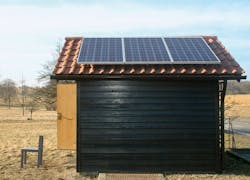Festo Now Offering Energy Self-Sufficient Automation Solution for Water Technology
Festo has developed a storm water holding tank solution that is energy self-sufficient. Solar and wind energy drive the gate valves of storm water holding tanks, most of which are located in areas without a normal power supply. Operators no longer have to open and close the valves manually to drain the stored water, thus saving valuable time and money.
Storm water holding tanks collect the excess water from the sewer system when there is heavy rainfall and thus relieve pressure on wastewater treatment plants and natural bodies of water. Once there is sufficient capacity available in the wastewater treatment plant again, the gate valves on the holding tank are opened to drain off water. Because the holding tanks are often located in areas where there is no normal power supply, valves have to be opened manually.
Energy Storage
The Festo solution uses solar and wind energy to generate electricity. It even stores energy for use whenever it is needed. The energy is used to power the control unit and operate the pneumatic actuators. If the power supply from one of the energy sources fails, a built-in emergency function ensures that the gate valves can continue to be operated several more times until a repair or replacement has been carried out.
Using a Festo GSM modem, the entire system can be controlled and monitored from the remote control center. The opening and closing of the gate valves as well as the status monitoring for the entire system can also be performed centrally. A data logger continuously documents the charge status of the accumulators as well as logging the charging behavior. The compressed air production times are also monitored and the data is transmitted to the control center. Leaks, problems with the power suppl, and other faults can thus be detected and rectified at an early stage.
Diagnostics With CPX
The heart of the pneumatic solution is a Festo electrical terminal type CPX combined with a valve terminal type VTSA. Users are thus provided with a complete energy self-sufficient system that can perform control tasks directly onsite and offers comprehensive diagnostics functions. Modules for temperature measurement, pressure regulators or even pressure sensors can be adde, and the signals can be processed via the CPX terminal.
The flow control valves are actuated with Festo pneumatic linear actuators type DFPI and DLP, some of which are equipped with positioners. When used outdoors, as is often the case with water technology, pneumatic drives are ideal. They are robust, corrosion-resistant, and can also be used in an ATEX zone. For the variable-speed actuator DFPI, displacement encoders and positioners are harmonized for optimum performance and integrated into a housing. This makes the solution extremely compact and ensures that all parts are protected.
Source: Festo
